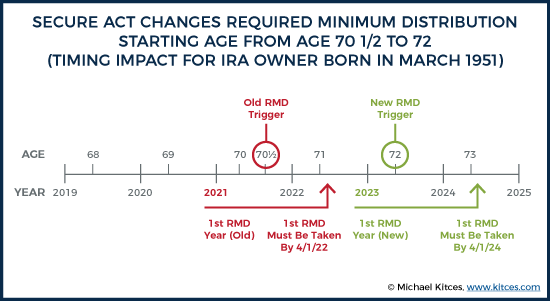It’s RMD Time: It Ain’t 70 1/2 Anymore!
In 2020, President Trump signed the SECURE Act (Setting Every Community Up For Retirement Enhancement) into law as part of a far reaching “Further Consolidated Appropriations Act of 2020”. Although the SECURE Act was only signed into law about a year ago (December 2022), it’s mandates are already impacting U.S. small businesses and their employees alike.
What are RMDs (Required Minimum Distributions)?
The first word in this acronym stands out and is key: Required. Required Minimum Distributions (RMDs) are minimum amounts that IRA and retirement plan account owners generally must withdraw annually. The first RMD must be taken by April 1st of the year following your 73rd birthday. Let me explain let’s say you turn 73 years old on August 1, 2023. In this case, your initial RMD would be start by April 1st, 2024. In other words, your first RMD must be taken by April 1st of the year after you turn 73. As a side note, if you were born after 1960, then beginning in the year 2033, the SECURE 2.0 will extend the age at which RMDs must start to 75 years old. There are a lot of moving parts. But as you can see above, the schematic by Michael Kitces, explains the RMD details much better than just words alone.
There are a lot of detail to RMD planning. As an example, retirement plan account owners (like traditional IRAs) can put off taking their RMDs until the year in which they retire (unless they own 5%+ of the business underwriting the plan). Just know this, if you choose to delay taking your RMD, you’ll need to combine your RMDs (first and second) in the same year. That may create a problem by pushing you into a higher tax bracket. Talk to your trusted tax advisor to ensure you are following the guidelines and deadlines! Because, as with all things government-mandated, if you miss your RMD deadline, the penalties can be severe. Here are the IRS guidelines.
A Reduced Penalty. Wait, What?
Yes, you read correctly. In the past, it was widely known in the planning community that RMD penalties were heavy. How steep? Well, under the prior rules, if a retiree overlooked or just flat-out missed the RMD deadline, they would be hit with a painful penalty of 50% of the amount not taken on time. Today, presently, that penalty has thankfully been reduced to 25%. And lessor yet, 10%, if you correct the oversight within two years.
By the way, even if you inherit a qualified (IRA, etc.) retirement account, it is still subject to an RMD. Note: Roth IRAs escape the RMD requirement in the account (IRA, etc.) owner’s lifetime, but get this: Your heirs will have to take RMDs). Nevertheless, overall, I like the changes and updates to RMDs. It allows hardworking Americans to keep their hard-earned money in retirement accounts for a longer period of time to earn more money for their future. And given the fact that we are all living longer, this can only help. -GW
At SEA Financial Hawaii, we do not provide tax, accounting, or legal advice. Clients should consult their own independent advisors as to any tax, accounting, or legal statements made herein. This material is being provided for informational or educational purposes only and does not take into account the investment objectives or financial situation of any client or prospective clients.

